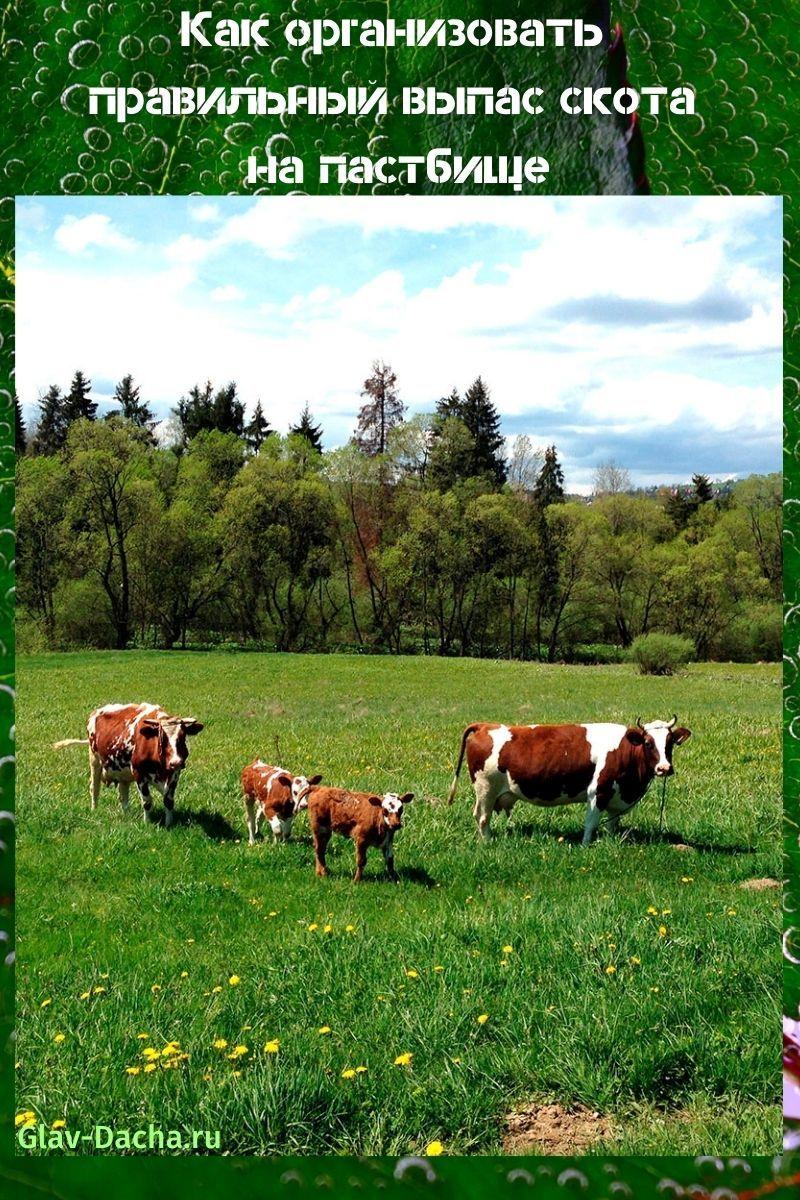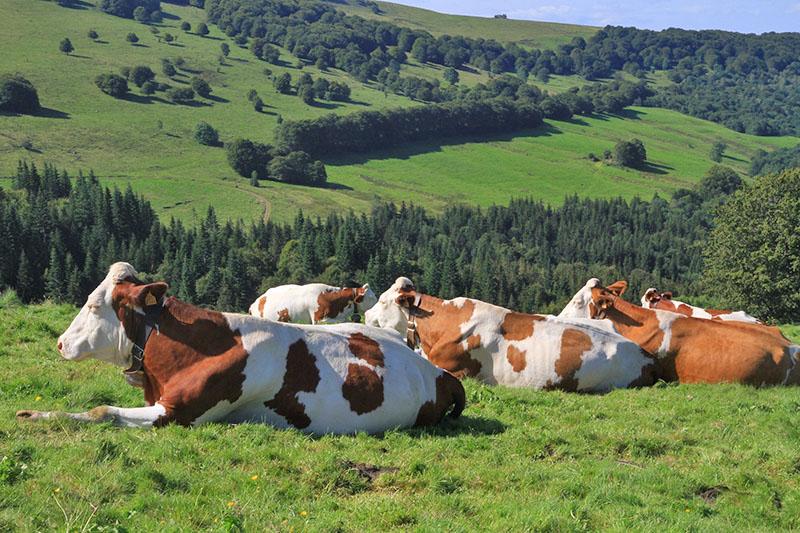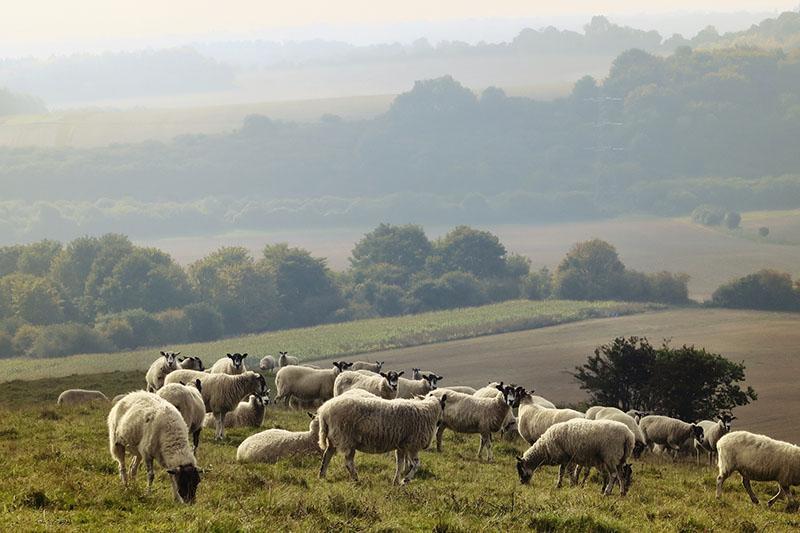How to organize proper pasture grazing
 On agricultural lands, where various varieties of grass grow abundantly, villagers drive domestic and farm animals to graze. Cattle grazing on a pasture, a land allotment for special purposes, is useful from all sides.
On agricultural lands, where various varieties of grass grow abundantly, villagers drive domestic and farm animals to graze. Cattle grazing on a pasture, a land allotment for special purposes, is useful from all sides.
Here rams and cows fatten, calves grow, using nutritious natural vegetation in the fresh air, adults mate for procreation.
Land classification by purpose
Long before the advent of land cultivation technology, cattle grazing in rural settlements took place on pastures. For this, the animals were assembled into herds, which in the morning the owners drove out of the households.
The shepherds gathered, grazed until sunset, and in the evening they drove to the gate of the house:
- cattle;

- goats with sheep;

- horses.

Usually, domestic cattle from collective or farm animals are grazed on separate lands. The livestock grazing field can be cultivated or natural.
Cultural arable land is sown:
- cereals;
- legumes;
- fodder.
Lands differ by type:
- dry land;
- watered;
- swampy;
- mining.
To increase milk yield or increase the mass of meat varieties, with the onset of warmth, the herd grazes in the meadow with a round-the-clock mode.
 When free grazing of livestock is impossible on pastures, due to mountainous or swampy terrain, they use the corral method of raising cows or sheep, which are kept in stalls, sheds, and farms.
When free grazing of livestock is impossible on pastures, due to mountainous or swampy terrain, they use the corral method of raising cows or sheep, which are kept in stalls, sheds, and farms.
Free pasture benefits
 Cattle and other types of livestock are grazed in grass fields all over the world. In Russia, weather conditions allow keeping animals on a plant-based diet for 4 warm months. Livestock breeders have proven through actual examples how good pastures are in contrast to stables.
Cattle and other types of livestock are grazed in grass fields all over the world. In Russia, weather conditions allow keeping animals on a plant-based diet for 4 warm months. Livestock breeders have proven through actual examples how good pastures are in contrast to stables.
In confirmation, the indicators are cited from practice:
- low cost of meat and dairy products, due to low costs for feed, the profitability of production increases;
- increased milk yield, an increase in the weight category with a high biological value of products, under the influence of the inclusion of herbs in the diet;
- high palatability due to the level of carotene as opposed to silage feeding;
- the health status of livestock is better compared to indoor housing;
- stable reproduction with a high degree of fertilization, calves are born viable, without pathologies.
In warm regions of the country, for example, in the Kuban, there are winter pastures, where sheep are driven out even in January-February.
Sheep roam the mountain heights, harvested fields, pick up the remains of corn, barley or dried plants, and in the evening the livestock breeder gives silage, root crops.
What are the rules for grazing livestock on a pasture
 The zealous owner is thrifty to the land. Ensures that the use of pastures is rational.
The zealous owner is thrifty to the land. Ensures that the use of pastures is rational.
The livestock breeder pays attention:
- a large herd will trample the grass, so no more than 150-250 heads graze on the field;
- calculate a green meadow of 0.5 hectares. per adult, 0.20 ha for 1 calf or lamb;
- Cattle begin to graze when the spring grass grows to 15 cm;
- from winter maintenance they are transferred to free grazing gradually, so that there is enough food for the first time, additional morning and evening feeding is carried out;
- they start grazing earlier in cultivated fields, in contrast to the natural growth of plants;
- save green meadows from overripening by timely mowing, thereby simultaneously increasing the quality of the forage base;
- do not let animals go to high forbs, since they cannot eat everything, they will only trample.
 The most succulent pasture grasses do not exclude the rest of the care.
The most succulent pasture grasses do not exclude the rest of the care.
Horses, cows and sheep need to be driven to a watering hole, salt licks should be placed.
What is Lean
 If you do not treat pastures with care, this negatively affects the vegetation and soil cover, water regime, microclimate, the state of fauna and flora. Animals eat grasses unevenly. Valuable species may disappear, and more resistant, low-growing weeds will grow.
If you do not treat pastures with care, this negatively affects the vegetation and soil cover, water regime, microclimate, the state of fauna and flora. Animals eat grasses unevenly. Valuable species may disappear, and more resistant, low-growing weeds will grow.
The result of improper use of pastures is that the quality of the herbage with microbiological activity deteriorates. The reason is excessive soil density and disturbances in the water-air regime.
In order not to start restoring destroyed fields with herbs, it is necessary to observe preventive measures:
- to provide rest to the land;
- graze on time;
- carry out top dressing, overseeding and mowing.
Such events will protect:
- the upper soil horizon from destruction;
- from flushing the fertile layer on the slope;
- decreased productivity of the meadow.
 On the land knocked out by livestock, harmful insects will actively reproduce. The shepherd must alternate the use of arable land - a year as hayfields, on the other to let cattle graze on the meadow.
On the land knocked out by livestock, harmful insects will actively reproduce. The shepherd must alternate the use of arable land - a year as hayfields, on the other to let cattle graze on the meadow.
Rational grazing will ensure the predominance of valuable plants in the herbage.
How to restore the feed base
 To protect the plantation from depletion, to increase the productivity of grass growth, effective measures are needed.
To protect the plantation from depletion, to increase the productivity of grass growth, effective measures are needed.
To restore the ground trampled by hooves, land:
- plow with a tractor;
- apply mineral and nitrogen fertilizers;
- sown with seeds;
- flooded in the dry season.
A set of measures, a timely assessment of the state of the field will improve the result.
Who controls grazing in pastures
 After the disappearance of collective farms, farms appeared, they contain animals and private owners. Regardless of the organizational and legal status of the enterprise, pastures are needed for the full development of livestock.
After the disappearance of collective farms, farms appeared, they contain animals and private owners. Regardless of the organizational and legal status of the enterprise, pastures are needed for the full development of livestock.
The local administration in each locality determines:
- organization of grazing;
- territory for pastures;
- sites for outbuildings with cattle walking.
Livestock breeders of any status are required to follow the order:
- graze cows or sheep in a fenced-in place, tie large ones, constantly watch small ones;
- let go of the horses hobbled;
- it is impossible to leave without supervision to graze near the roads for transport;
- the owner is obliged to issue a grazing permit in a certain place;
- animals must be in a pasture with marking numbers;
- disposal of dead individuals is prohibited without notifying the administration staff.
 Local self-government bodies create their own rules on how to graze animals, instructions do not contradict the legislative provisions of the Russian Federation.
Local self-government bodies create their own rules on how to graze animals, instructions do not contradict the legislative provisions of the Russian Federation.
To avoid penalties for violations, it is necessary to clarify in advance the procedure, conditions for walking, keeping livestock in a particular region.
For the productivity of a livestock farm, pastures with grasses from valuable varieties are needed. Meadows with cultivated sowing of plants from 4 varieties ripening at different times will be able to fully provide a large herd with a forage base. These include clover, a legume variety. On such fields, the grass is pitted at least 10 times during the season.
 It should be noted that with unregulated grazing, animals are not restricted in movement. They try to absorb only young shoots, which quickly disappear. More resistant sow thist remains, grows old and loses its nutritional value, which is why milk yield and weight decrease. When grazing is regulated, livestock is allowed only to those areas where the yield and quality of herbage will not decrease, the productivity of the dairy and meat industries increases.
It should be noted that with unregulated grazing, animals are not restricted in movement. They try to absorb only young shoots, which quickly disappear. More resistant sow thist remains, grows old and loses its nutritional value, which is why milk yield and weight decrease. When grazing is regulated, livestock is allowed only to those areas where the yield and quality of herbage will not decrease, the productivity of the dairy and meat industries increases.